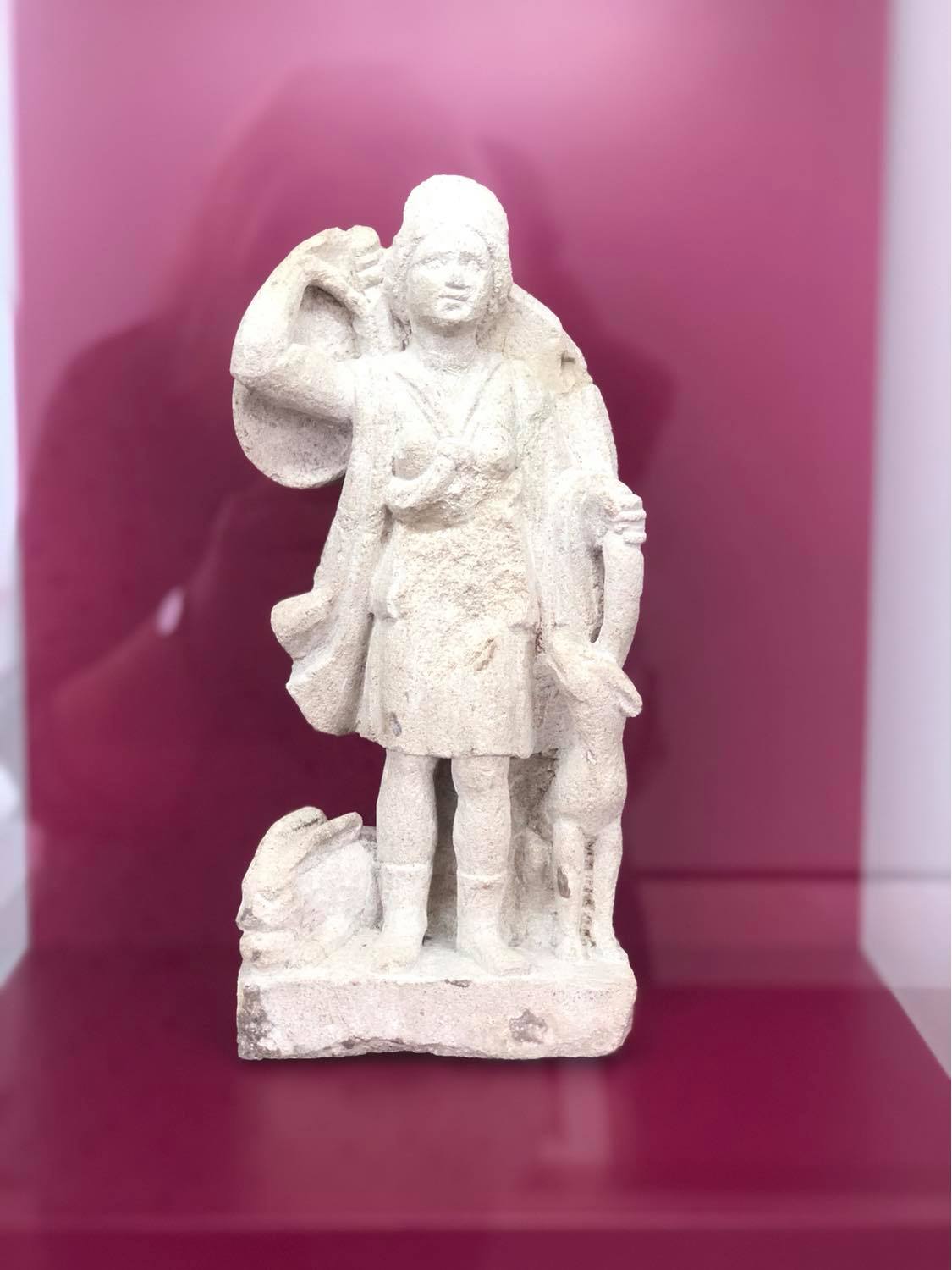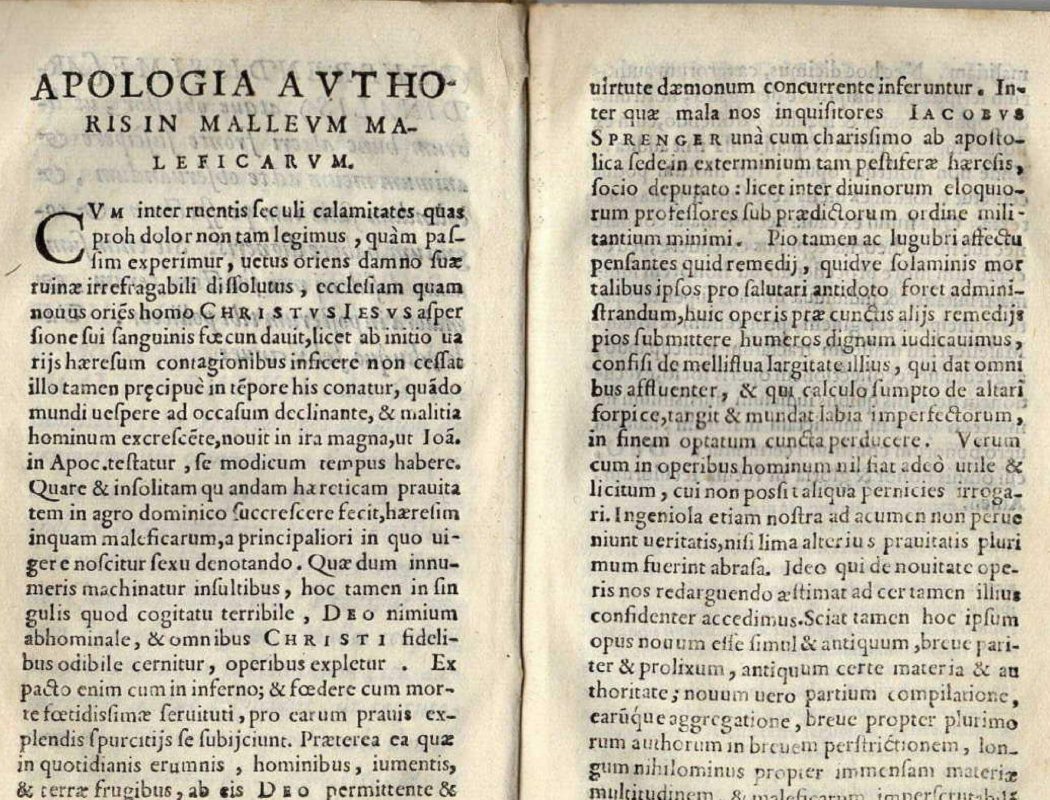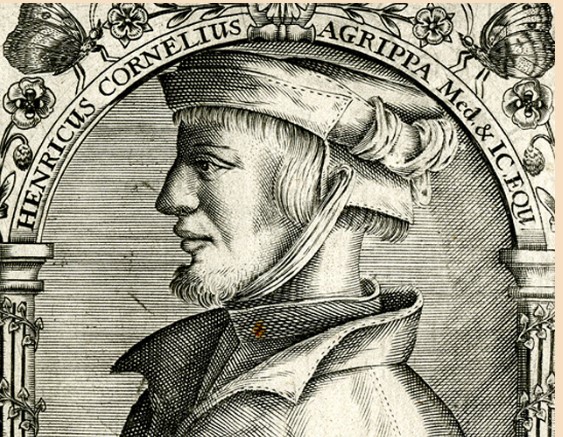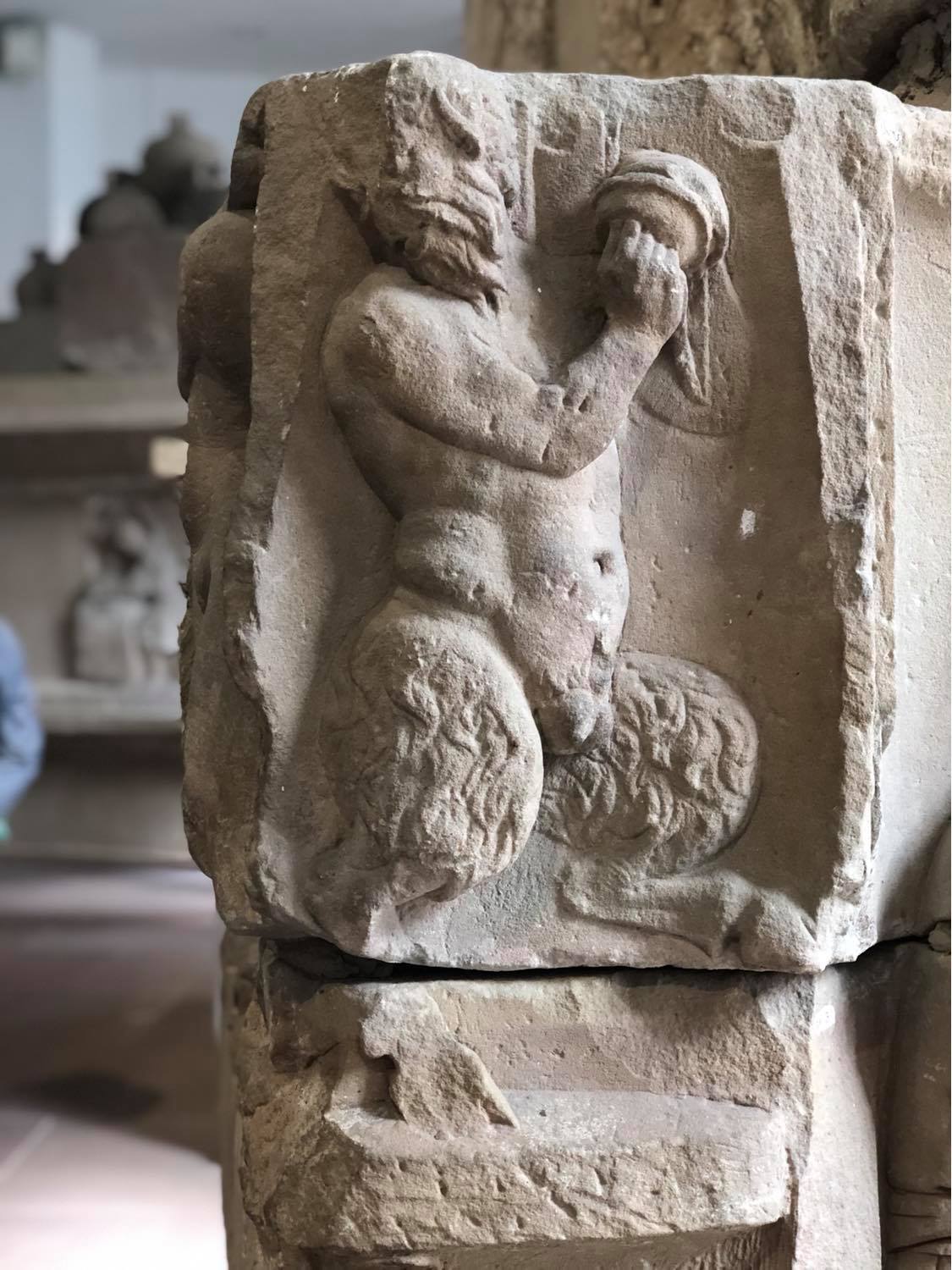This is a short summary of what I found in books and exhibitions in many years and the thesis of Alena Prieß for her diploma for the University of Vienna, 2012 (“The motive of dreams in the witches’ flights”)
Concerning archaeological discoveries there are many proofs for a shamanic and religious life in Pre-Christian Germany. But since there are no written sources or – if there are any – they were written down by Romans – there is no clear evidence of the beliefs and rituals in Pre-Christian Germany. So it’s hard to say at what time the witch as a person working with magic (or blamed to do so) appeared on the scene.
Wherever the Romans settled their rituals and feasts for the pagan goddesses and gods of the Mediterranean area were commonly known and often taken over by local people – or even mixed.
There are quite a few temples in Germany left and especially Kybele, Isis, Diana/Artemis, Minerva (I don’t mention the male ones) had their followers everywhere – Romans and Germans as well (and whoever was part of the Roman army).
So in antiquity people knew about the goddess Diana and her followers – the strigae.
During the first centuries of Christianity those Pagan cults didn’t lead to displeasure because the early Christian church had to fight for its survival itself. But with the council of Nicaea in 325 the Roman church became far more established and people started to discuss the principles and structures of their beliefs.
Until the Middle Ages there seems to have been some tolerance towards shamanic traditions and those little, so to say, everyday spells. Even during Roman times the working with harmful magic had been officially forbidden. But considering how many little tablets with all sorts of spells were found around the Temple of Isis in Mainz (and in other places as well) this prohibition can’t have been taken very seriously. And the curses are quite explicit like wishing death to rivals in love affairs and so on.
Obviously, it was a problem anyway to divide spell working by common people from ritual magic practised by the church itself. From the common people’s side they used all sorts of spells which were remnants of a more shamanic past mixed with healing spells since there was no common medical treatment available. But it is quite remarkable that there were holy masses as well which contained rituals to keep rats or bad weather away. The influence on climate and weather was a crucial point in the opinion about people working with spells.
While the basic image of the strigae was somewhat ambiguous and not seen to be worthy to be sanctioned, harming spells which might destroy the harvest were not accepted. Apparently the rumours of the flights of the strigae didn’t bother people too much and the witches’ flights were still not object of a common discussion until around 1000.
There is a difference between the valuation of a magical flight and the use of magical spells. First of all it was a matter whether people actually believed that magic really existed. It’s quite strange but the flights where seen from a different perspective than other sorts of magic.
This is the result of the points of view on reality in the Middle Ages. The witches’ flights were believed to be the results of dreams. But there were two different theories of what dream actually were – the pre-Christian point of view by Aristoteles and the Christian point of view.
While Aristoteles wrote that there are different ranges of consciousness and all of them together make the soul of men and that dreams reflect this soul, the Christians said, the dreams are beyond that and that they are the medium for conversation between God and men (a very shortened and simplified description by myself). So – if the flights were merely dreams how should they be seen in the connection between God and men ?
The witches’ flights were mentioned the first time around 800. They were connected to the old Roman goddesses as the German spirits like Holle, Holda and later the Perchten. Until then all sorts of witchy behaviour was tolerated although from Karl dem Großen / Charlemagne onwards the practise of magical spells was basically forbidden.
In the beginning of the 10th century the ‘Kanon Episcopi of Regino von Prün’ documented that women reported about flights. I didn’t read the Canon completely but apparently he writes quite a lot of the flying women, which was later taken on by Burchard of Worms and others.
It’s a strange mixture of denying magical acts and still thinking them to be possible at the same time. Flights were basically seen to be results of dreams. Contrary to later times the representatives of the Church didn’t see a crime in using spells and charms but rather in believing in witchcraft and magic. The problem was the attitude of the offender towards magical practises as non-Christian practises and not that much in using it.
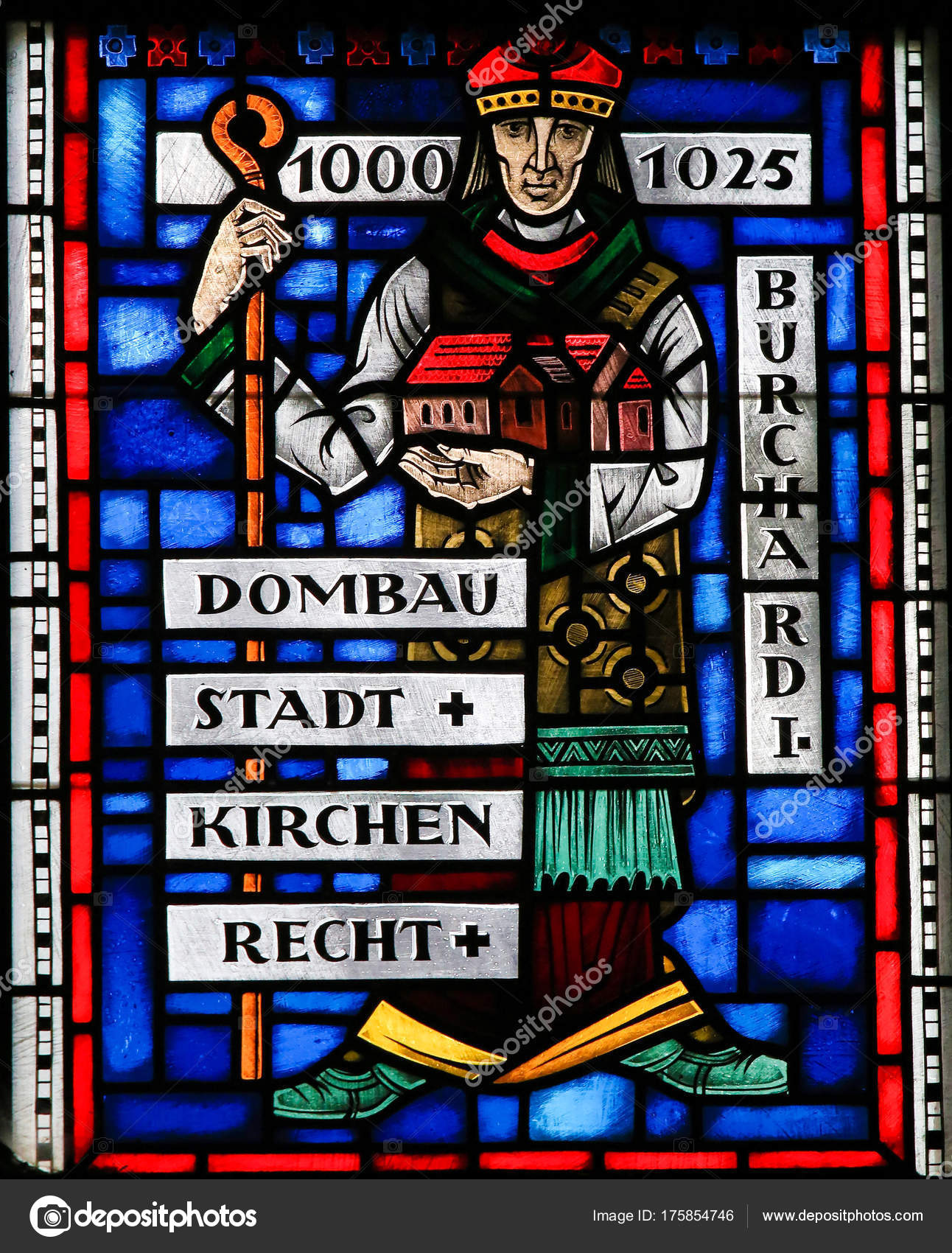
WORMS, GERMANY – JULY 4, 2017: Stained Glass in Wormser Dom in Worms, Germany, depicting Burchard of Worms, bishop of the Imperial City of Worms, in the Holy Roman Empire.
Burchard of Worms, who had noticed that there were enormously many variations of the Church laws in circulation, collected them and they became a standard which was in use until 1919. At his time church law and worldly jurisdiction were still separated and so the sanctioning of a violation of Christian principles couldn’t lead to a worldly trial and punishment. Since the practising of witchcraft showed a lack of Christian spirit it didn’t need physical punishment but it asked for repentance. Those who weren’t willing to regret and repent could be excluded from the Christian community.
Unfortunately, the same regulations were later used to argue in the opposite direction and to handle the whole problem in a totally different way. Until then it is not explicitly a female ‘problem’ even when the old stories rather told of women flying with the old goddesses. Another important point is that the devil doesn’t play a role at this time. During the 12th century the strigae vanish from the documentations and the devil takes their place. Not only witches’ rides but witches’ ointments and fortune telling become the work of demons.
The political scenery also changed – the position of the popes had become weaker. There were constant struggles with the German emperors and kings, Islam was spreading and there were Christian groups coming up who wanted to live their spiritual life after their own fashion. The Inquisition was founded, the leading force being the order of the Dominicans.
Apart from that there were climate changes and bad harvests which increased the crisis. In addition to that, some popes were extremely superstitious. The borderline between first steps of science, a magical or a religious interpretation of concepts was very narrow. And still people couldn’t make their minds up about what they saw as the result of dreams where these dreams came from and what to think of them.
Another aspect is whether a flight for example. should be seen as imagination or illusion. The distinction is important for the quality of perception of the individual. If it is only an illusion – as Burchard thought – it was possible to interpret magical practises or whatever was connected with witches as personal misconception. Repenting seemed to be a moderate but sufficient sanction. There were several supporters of this comparatively mild version but there were always others, too.
And again the meaning of dreams was of importance. Are dreams prognostic? Is this prognostic aspect acceptable from a Christian point of view? The range of ideas which were discussed was very wide. People tried to find hints in the Bible how to judge all these problems. But the Bible didn’t give any clear criteria as well. For example, the forecast of fortune has been seen in most cases negatively but as Thomas Aquinas wrote there had to be a difference between divine inspirations and illusions caused by demons.
But up to this time the whole discussion didn’t focus on women, specifically in its argumentations. From 1300 onwards there were attempts to explain the tendency to dream of flights with “scientific” reasons. Relating to the 4 body fluids, the tendency to dream of flights was assigned to melancholia. But although there were the attempts to explain magic and witches’ flights with rather psychological or medical reasons or see it with some tolerance like Burchard von Worms and others the tendency to see it rather as the result of demons became overwhelming.
So there was a change of argumentation on one hand and on the other hand the Dominicans on the road who had already successfully destroyed the heretics and now they needed new tasks. There has to be the consideration as well that since Pope Innocence the 3rd (I think it was him) the competences of the forces of the church were extended. Before, jurisdiction and executive forces were separated from the competences of the church.
Since the Council of Constance and Basel, representatives of the church were allowed to hunt, judge and punish people who were accused of practising witchcraft. So there was the legal foundation made on one hand. The ideological justification followed.
In the 15th century the idea of the witches’ flight as a phenomenon in a dream disappeared into the background. The flight became reality. The former pagan goddesses (obviously so far not blamed to be evil on their own behalf – the sinner was the one who still followed them) withdrew in the background and were replaced by demons or devils.
A change for the worse came up with the text called the “heretic’s scourge” by the Dominican Nicolaus Jacquier (+1472). Actually inquisitor in the North of France he became very important in Germany, too. He equated the heretics with witches – based on the opinion that witchcraft with all the negative aspects it was related to, actually exists and is not only a phantasy. All bad deeds were carried out with the help of demons. The combination of heresy with the ability to produce harming spells was a very important change in German law system because only then death penalty was possible.
In the 1470’s Heinrich Institoris was employed as the main inquisitor. Usually inquisitors were only responsible for certain areas but he got a general power of attorney. Together with Jakob Sprenger he worked in the late 15th century and reported that they had found out through tormenting the (female) accused persons that there was a huge sect of heretics in Germany – obviously identical with the witches. The so called “Hexenbulle” listed all crimes the witches of that times where accused of. For some reason, the only exception was the witches’ flight. But instead of this the witches sabbath was included.
Heinrich Institoris Kramer is famous for writing the “Hexenhammer” – the systematic manual for the witch hunt. While worldly courts used to see witchcraft as maleficum – meaning being a victim of witchcraft – Institoris and Sprenger rather saw a heretical act and spiritual evil. In opposite to the former points of view by Burchard and others Institoris and Sprenger demanded the strict punishment of witches. The idea of the illusion of witchcraft changed into a fact.
The flight to meetings with the devil became a crucial point in the accusations. Since the meetings often were far away from the places where the accused people lived it seemed to be obvious that they could only have got there by flight. The basic change to the earlier centuries was that the inquisitors – Dominicans and Franciscans in first place – actually only used these accusations to justify a system where heresy and witchcraft were mixed together.
Most of the so called heretical groups or wandering monks who followed their own image of Christianity were situated around the Alps and the south of France and not really in the area of today’s Germany. But after having destroyed most of these groups they had to find a new prey which were people working with magic or witches – or people they could blame to do so. The texts of Regino and Burchard were now interpreted the other way round as evidence that people worshipped demons, and namely the devil.
It’s hard to say whether the old pagan traditions from the Mediterranean areas or the north actually survived and were still practised but in the minds of the people they were not forgotten. They got another quality and that what was formerly known as remnants of antique beliefs was turned into a present cult although the goddess changed into a “Fee” (faerie) with a bad reputation.
Apparently these faerie beliefs were especially spread around in the areas where the inquisitors travelled, which may be a sign that they were responsible for the spreading of these ideas, which became part of the common faerie tales. These faerie queens were connected to the god Pan who was later easily identified with the devil. Included was the sexual intercourse with demons and the devil which couldn’t be found in earlier texts because in former times people were not sure whether a sexual intercourse between a human and a demon was physically possible. They came to the conclusion that it was only possible with the interference of a succubus or incubus. But all these things were only academic discussion by Augustinus or Thomas Aquinas. But since they were mainly interested in the basic structures of Christian beliefs they only mentioned the problem but didn’t consider consequences.
This changed very much through the Inquisition where heresy and demonology became the central topics. Still there were voices coming up of people who insisted that the accusations had no substance and were most unreasonable but through the increasing number of trials and evidences given under torture those who thought the Inquisition was justified seemed to be proven to be right.
Times between 1100 and 1400 were hard, there were great famines, wars and changes in social structures. Germany was no political unity and consisted of many small political areas with their own jurisdiction. People were frightened because of the whole situation, which led to a social tenseness. In these times of the witches trials old women were overrepresented because women more often survived to reach an older age than men. They were often very poor and had to beg. Obviously, they didn’t have any political support at all. They were predestined to be the right victims in the beginning.
Women were said to be the easier prey of the devil anyway. In the famous Hexenhammer / Malleus Maleficarum it is written that the Latin word femina for woman consists of fe (glaube=belief) and mina (weniger/less) meaning that women were less able to belief anyway. Because of that it was easier to seduce them and they wouldn’t have the will power to resist the temptations of the devil.
In the beginning of the 16th century the discrepancies between the classical antique points of view about what a dream is, the different levels of consciousness and the Christian points of view still existed.
With the beginning of a more scientific approach towards phenomena there were more people denying the possibility of people flying around (Hans Sachs, Johann Weyer, Hermann Wittekind and – very important – Agrippa von Nettesheim (who is interesting enough for a separate article!). On the other hand there were people believing in the accusations on an international level (e.g. Jean Bodin) and their books were soon translated, and since the invention of book printing were very soon widely spread.
An interesting case is Paracelsus (actually Swiss) – although a scholar at his times – having a very negative image of women in general and especially witches. He shaped the image of the witches very much. After his opinion witches were women with a negative attitude towards men. They were leading a way of life not according to nature and neglected their households and their personal hygiene as well. Being a Doctor of Medicine himself he pretended to have observed that witches had a bad physical appearance, with abnormal body characteristics (hunchback) and he related it to a certain model of signatures. The physical typification was crucial for the mental state as well. According to him, witches had access to spiritual spheres from below to the heavenly spheres but abused them with their evil minds.
The interesting thing is that Paracelsus believed in naturally existing magic (magia naturalis) meaning that all secrets of nature lay within it (as basis for modern science as well). Witches were connected to dark magic, inspired through greed and envy. And people like that should be destroyed by fire.
His counterpart is Agrippa von Nettesheim. He tried to achieve a symbiosis between magic and science. As a scholar in many subjects he thought that there is a soul and life even in the smallest particles and there is a soul of the world as a whole as well. Humans are part of the microcosmos while the “Weltenseele” is the macrocosmos. Humans must have a share in this macrocosmos and since the soul of the human can fly, magic was after all the way to understand God. Because of the cognitivity of soul, the whole cosmos was open for humans and because of that they could achieve to control the hidden forces of spirits and demons.
As a lawyer he supported a woman in a witch trial and although everybody expected her to be sentenced, he managed to get the woman free because the judges were not able to disprove him. Of course this meant danger for himself, too, and he had to defend himself as well. His pupil Johann Weyer was later even more successful with defending witches.
Luther was a strong opponent of these ideas. First of all his image of the devil manifested as the symbol of evil, of dark powers, being more or less invincible when once caught by him. Until then, in fairy tales the devil was often outwitted by a clever farmer but now he got a quality beyond that. Luther puts everything a witch might do in connection with the devil and now the motive of the dream which might stand behind a flight is the devil’s cheat, and everything a witch does is only the Devil’s work. In this context the meaning of the witch, striga or whatever, has a direct and exclusive link to the Devil – meaning that whatever witches do, it must be connected to something harmful.
In the second half of the 16th century with the oncoming of more scientific theories, the dreams of flights or other magical activities were explained by a disbalance between the body fluids – in this case causing melancholia.
Since the Middle Ages melancholia described a psychic state of mind which led to a disinterest in God and sadness which again may lead to despair (concerning to Luther the result of the devils influence again). The story of Dr. Faustus is a good example for that – and obviously not only a female problem.
Johann Weyer is an important representative of a new humanistic way of thinking which opposed the ideas of the Hexenhammer. Although he basically believed in the existence of the Devil and magic, he thought that there is a difference between a Satanic deception and the conscious calling of dark spirits by a magician who willingly works with black magic. Apart from that he mixes physical with psychological states.
He follows Aristoteles’ ideas of dreams as the results of human consciousness but explains dark dreams with physical problems caused by digestion. A large, heavy meal in the evening might cause a bad dream. So he rather sees one’s living style as the background for having strange dreams. The perception of a witches’ flight is the result of a state of physical lability which makes the witches believe that their “experiences” actually took place. Because of that the accused witches would insist during the trials that everything happened as reported. So there are various theories concerning magical activities and witches.
Another extraordinary question is why people thought that witches didn’t react in witches tests as should be expected after the laws of science. Especially the water proof was used quite frequently to test a witch. It had to be explained why witches wouldn’t drown when thrown in water. The explanation was soon found. The answer is that the devil took everything physical and non-physical away from a person so that nothing was left of them, and with no substance they couldn’t have physical weight. Apart from that, God had chosen water to cleanse the individual from sin (Baptizing). Because of this, water would refuse to accept a witch and she had to remain on the surface.
Again there were many pros and contras but the shocking fact is that most people died as victims of the witch trials between 1650 and 1785 – actually quite a long time after the so called Dark Middle Ages. There are lots of files left which show details of what happened. People of all ages were accused: women, men and children. Rich and poor. People with reputation and without.
Looking behind the accusations (which were usually more or less the same) there were in most cases very human interests behind them. After all the theological debates it must be clearly seen that the witch trials wouldn’t have been possible if there wouldn’t have been a big consensus in the population. Of course it is obvious that there were many more trials along the travelling roads of the inquisitors but in later times it was a matter of the worldly councils to arrest, judge and punish the delinquents.
Concerning the files it is obvious that people were blamed for very worldly reasons – usually greed and envy. Somebody was after the land of an old widow; a child didn’t like stepmother and so on. People blamed family members (which wasn’t very clever because later they were usually accused themselves since it seemed unlikely that the Devil was only after one person in the family).
People were blamed for being not pious enough, others for being too pious. In Trier quite a lot of people died – especially men and of comparably high rank. In the area were my family comes from, more than 2000 people died although it’s a very rural area with not too many inhabitants – people of all genders and ages. In the city of Frankfurt nobody was accused because the city councils didn’t think much of witch hunts. There are Catholic areas with many victims and Protestant areas with many victims too. It’s a big variety. In these late times it seems that the witch hunts were used in the first place to get rid of certain people.
In conclusion, one could say that the interesting thing is that people were aware that there were old beliefs before Germany became Christian. But in the early centuries it was still seen as a remnant of the Romans. At the time of Regino and Burchard, goddesses of a rather German background were mentioned and they started to replace some of the old ones (although Diana seems to have remained in the mind of the people). But there is no clear proof of how far old cults were still practised.
I did not find anything about a cult for a male god like the old Mithras cult, which spread at least in the areas where the Romans had been. Not to mention a cult around the local Germanic or Celtic gods.
Later the god Pan is mentioned but I didn’t find any hints whether and in which way he has been worshipped in Germany during the Middle Ages. Maybe later he has been rediscovered, especially by artists who were interested in more than Christian sceneries.
Concerning the texts of the earlier representatives of the Church through all times harming spells must have been practised – probably a tradition from ancient times. But it doesn’t prove that there was any sort of religious cult connected with it.
I think it’s very interesting to read about the theories of the flights and the connection with dreams and the state of consciousness of people and especially the interpretation of it. It obviously kept people busy thinking and considering from the earliest times until today. And it is definitely very interesting. Unfortunately, the discussion went totally astray in the Late Middle Ages.
I think it’s difficult to find traces of Wiccan ideas in the German part of the history of the witches. Many basic texts were written by other people but there were copies available here from a very early time onwards, and after Gutenberg, translations and prints spread everywhere anyway.
There were certainly groups of heretics who had interesting ideas like for example, that there is no devil but all – good and evil – is in ourselves (matter of polarity?) but they were not really a German topic. As far as I know, they were not really prosecuted that much here until the Dominican inquisitors were sent out and I know of more cases in France and Italy and the Alps maybe.
Seeing old traditions in rural areas or even at Christian celebrations there are certainly many remnants of pagan life with a shamanic background. But I think it’s difficult to see a straight relation between a shamanic past and a lasting goddess cult here in Germany. It’s not impossible but there is no certain proof as well.
It’s a tragedy that fairly peaceful concepts like those of Regino von Prüm, Burchard and Agrippa von Nettesheim, were abused and turned around into the opposite argumentation. Maybe there would be more historical material if the things hadn’t come as they did.
We often see the witch trials as an historical impact but actually the development of religious beliefs, the acceptance of dissenters is a topic until this day. It was and is a process where we still don’t know where it might lead to. I’ve already read quite a few articles and seen reports but for some time it almost seemed as if the suffering of the accused witches – male or female – led to some sort of voyeurism. You could see and read about so many cases of people being tormented and of course everybody knows the Hexenhammer. But the actual background is often not really well analysed. Obviously not everybody in the past was a brutal friend of physical torment. There were thoughtful minds too.
It is another matter whether there are sexual aspects behind the accusations of being witch. Obviously in the beginning it was women who were said to be followers of the old goddesses. But I think it is a very complex thing because we have to question the basic attitudes of the Inquisitors and everybody else involved as well. And seeing that there were so many male victims as well it’s a very ambiguous topic.
But in all of this the actual witch or the dealing with magic, especially by the common people, remains somewhat vague.
Silvia Schwikart, February 2021
References, notes:
The document of Alena Preiß was very handy because it is well structured in its historical course.
A very informative book is Hexen – Mythos und Wirklichkeit. Published by the Museum der Pfalz, Speyer, on the occasion of an exhibition in 2009. It contains interesting articles which have been my sources as well.
Note from Morgana:
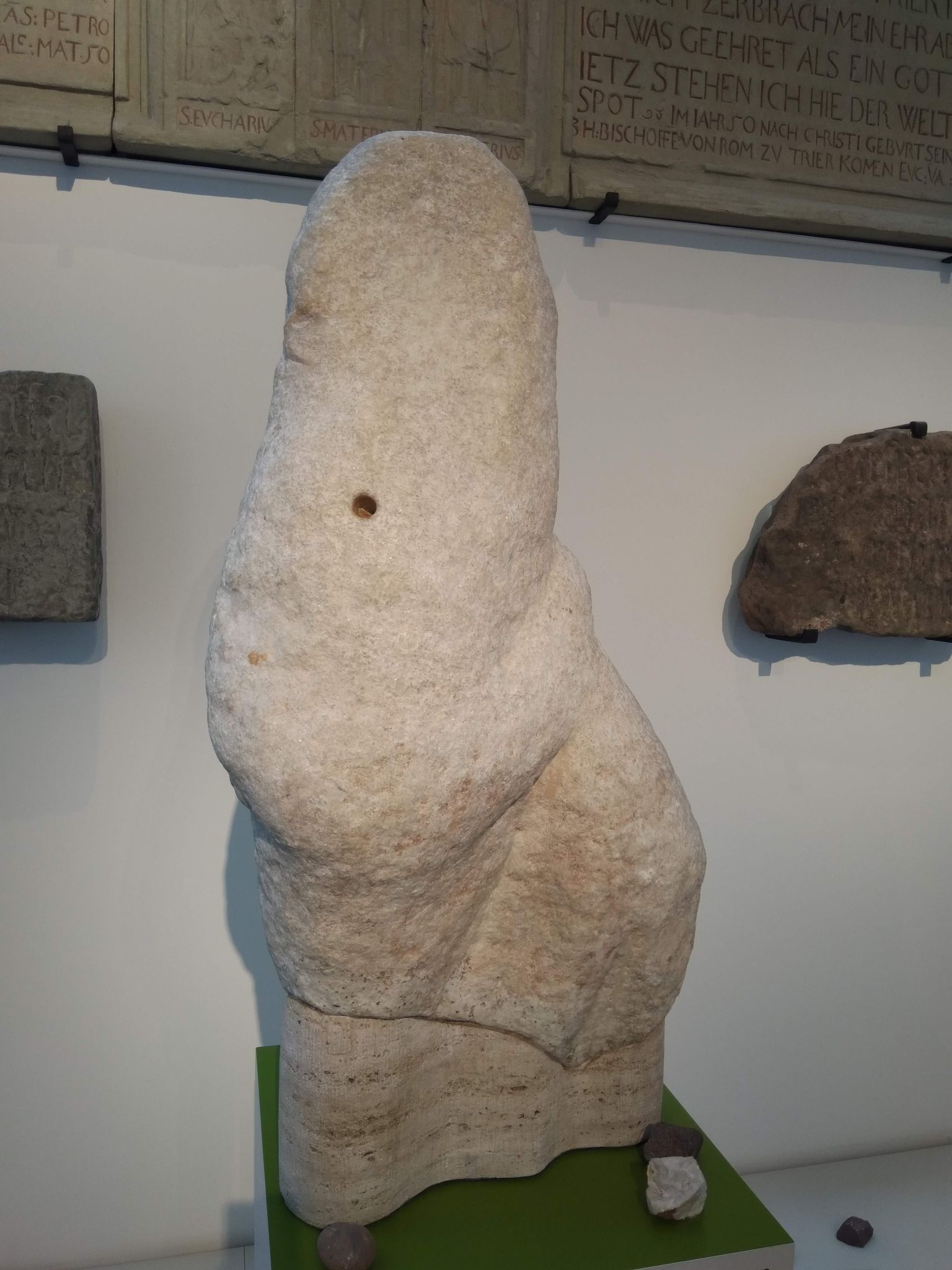
The Mattheiser Venus or Venus of St. Matthias, completely desecrated after many years of stoning – Morgana
The Mattheiser Venus or Venus of St. Matthias was an ancient Roman marble statue of the goddess Venus, which was formerly kept at the St. Matthias’ Abbey. The statue of the goddess of love was kept on display in chains by the wall of the monastery marked with the following inscription:
- „WOLT IHR WISSEN WAS ICH BIN
ICH BIN GEWESEN EIN ABGOTTIN
DA S. EVCHARIVS ZV TRIER KAM
ER MICH ZERBRACH MEIN EHR ABNAHM
ICH WAR GEEHRET ALS EIN GOTT
IETZ STEHEN ICH HIE DER WELT ZV SPOT.“
It was an established custom at the monastery to stone the statue annually to ritually celebrate the victory of Christianity over “Paganism” by annual desecration of the statue. This custom allegedly took place since the Middle Ages, but is confirmed since at least 1551. The statue was reduced to rubble, but the remains of it were transferred by the French commander of the town to a historical society in 1811. It is now kept at the Rheinisches Landesmuseum Trier.[3]
Loosely translated:
“DO YOU WANT TO KNOW WHAT I AM
I HAVE BEEN A GODDESS
DA S. EVCHARIVS ZV TRIER
CAME TO ME DESTROY MY HONOUR
I WAS HONOURED AS A GODDESS
NOW I AM THE WORLD ZV SPOT (PLACE).”

